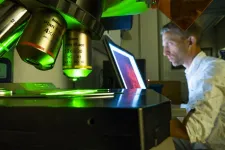(Press-News.org) Researchers perform experiments that can add or subtract a single quantum of sound--with surprising results when applied to noisy sound fields.
Quantum mechanics tells us that physical objects can have both wave and particle properties. For instance, a single particle--or quantum--of light is known as a photon, and, in a similar fashion, a single quantum of sound is known as a phonon, which can be thought of as the smallest unit of sound energy.
A team of researchers spanning Imperial College London, University of Oxford, the Niels Bohr Institute, University of Bath, and the Australian National University have performed an experiment that can add or subtract a single phonon to a high-frequency sound field using interactions with laser light.
The team's findings aid the development of future quantum technologies, such as hardware components in a future 'quantum internet', and help pave the way for tests of quantum mechanics on a more macroscopic scale. The details of their research are published today in the prestigious journal Physical Review Letters.
To add or subtract a single quantum of sound, the team experimentally implement a technique proposed in 2013 that exploits correlations between photons and phonons created inside a resonator. More specifically, laser light is injected into a crystalline microresonator that supports both the light and the high-frequency sound waves.
The two types of waves then couple to one another via an electromagnetic interaction that creates light at a new frequency. Then, to subtract a single phonon, the team detect a single photon that has been up-shifted in frequency. "Detecting a single photon gives us an event-ready signal that we have subtracted a single phonon," says lead author of the project Georg Enzian.
When the experiment is performed at a finite temperature, the sound field has random fluctuations from thermal noise. Thus, at any one time, the exact number of sound quanta present is unknown but on average there will be n phonons initially.
What happens now when you add or subtract a single phonon? At first thought, you may expect this would simply change the average to n + 1 or n - 1, respectively, however the actual outcome defies this intuition. Indeed, quite counterintuitively, when you subtract a single phonon, the average number of phonons actually goes up to 2n.
This surprising result where the mean number of quanta doubles has been observed for all-optical photon-subtraction experiments and is observed for the first time outside of optics here. "One way to think of the experiment is to imagine a claw machine that you often see in video arcades, except that you can't see how many toys there are inside the machine. Before you agree to play, you've been told that on average there are n toys inside but the exact number changes randomly each time you play. Then, immediately after a successful grab with the claw, the average number of toys actually goes up to 2n," describes Michael Vanner, Principal Investigator of the Quantum Measurement Lab at Imperial College London.
It's important to note that this result certainly does not violate energy conservation and comes about due to the statistics of thermal phonons.
The team's results, combined with their recent experiment that reported strong coupling between light and sound in a microresonator, open a new path for quantum science and technology with sound waves.
INFORMATION:
G3BP proteins inhibit the metabolic driver MTOR - a signaling protein that plays a central role in tumor diseases and developmental disorders of the brain. This is reported in this week´s issue of the renowned journal Cell. The study was led by scientists from the University of Innsbruck and the German Cancer Research Center (DKFZ) in collaboration with the Medical University of Innsbruck and a Europe-wide research network.
The signaling protein MTOR (Mechanistic Target of Rapamycin) is a sensor for nutrients such as amino acids and sugars. When sufficient nutrients are available, MTOR boosts metabolism and ensures that sufficient energy and building blocks are available for the growth ...
It is clear that COVID-19 has drastically changed our world, but how can we use the lessons learnt to build a more resilient and sustainable future? The International Institute for Applied Systems Analysis (IIASA) and the International Science Council (ISC) have drawn on the combined strengths and expertise of the two organizations to help find a way forward.
The COVID-19 pandemic, which has impacted almost every aspect of our lives over the past year, is a warning: We need to step back from business-as-usual onto new transformative pathways to reach the Sustainable Development Goals and the commitments of the Paris Agreement. Systems science is ideally positioned to address global impacts ...
For those who are diagnosed and have begun treatment for HIV, it is standard practice to regularly monitor viral load in the blood to assess response to treatment. A study of people living with HIV in Ethiopia shows that poverty and labour mobility are linked to high viral load despite treatment, indicating treatment failure. The researchers behind the study recommend that socioeconomic conditions should be taken into account to a greater extent in low-income countries to ensure that HIV treatment can achieve the best possible results.
Treatment using antiretroviral therapy (ART) is the same across the globe. For people living with HIV in low-income countries, however, ...
Study conducted by researchers from the GIGA CRC In vivo Imaging laboratory at ULiège demonstrates, for the first time in humans, how the first deposits of tau proteins in the brainstem are associated with neurophysiological processes specific to the early stages of Alzheimer's disease development.
During the pre-clinical stages of Alzheimer's disease, i.e. when subtle changes are taking place in the brain but no cognitive symptoms can be observed, the cortex presents a state of transient hyperexcitability. To date, several studies conducted in animals have shown that tau and beta-amyloid proteins - central to the development of Alzheimer's disease - were associated with increased cortical excitability and dysfunction ...
Olive trees are some of the most important woody crops in the world and Verticillium wilt, caused by the Verticillium dahliae fungus, is the most concerning disease for farmers in the olive sector.
In Spain, the leader in olive oil and table olive production, the increase in Verticillium wilt is primarily due to taking over infested soils formerly used for cotton (one of the main hosts for this pathogen) and the spread of a defoliating variant of the pathogen, which is more ferocious and ends up killing the olive tree.
This is why agronomy research efforts are focused on the search for the most resistant crops and the implementation of practices that reduce disease rates. In this vein, UCOLIVO Group researcher Juan Moral at the María de Maeztu Excellence Unit, Agronomy Department, ...
ISIS, Al Qaeda, and the Taliban use their English-language magazines to encourage women to support jihad in different ways, according to new research.
Experts hope highlighting these varying recruitment strategies will be of use for those trying to stop radicalisation and terrorism.
The Taliban-produced magazines encourage women to carry out a traditional role in the home and support men rather than to be violent and commit jihad themselves. Tahrik-e Taliban Pakistan (TTP) and ISIS encourage women to be violent - to pick up arms and fight. The magazines encourage women to leave their husbands if they don't support jihad, even without permission.
Researchers from the University of Exeter analysed ...
Scientists have identified that the evolutionary development of human and primate brains may have been similar for communication and memory.
Although speech and language are unique to humans, experts have found that the brain's pathway is similarly wired in monkeys which could signify an evolutionary process dating back at least 25 million years.
In a study, published in the journal Neuron, teams led by Newcastle University and the University of Iowa, compared auditory cortex information from humans and primates and found strong links.
Professor Chris Petkov, from Newcastle University's Faculty of Medical Sciences, UK, said: "Our language abilities help us to crystallise memories and make them vivid, such as 'the singer sounded ...
Certain anchor proteins inhibit a key metabolic driver that plays an important role in cancer and developmental brain disorders. Scientists from the German Cancer Research Center (DKFZ) and the University of Innsbruck, together with a Europe-wide research network, discovered this molecular mechanism, which could open up new opportunities for personalized therapies for cancer and neuronal diseases. They published their results in the journal Cell.
The signaling protein MTOR (Mechanistic Target of Rapamycin) is a sensor for nutrients such as amino acids and sugars. When sufficient nutrients are available, MTOR boosts metabolism and ensures that sufficient energy and cellular building blocks are available. Since MTOR is a central switch for metabolism, ...
All the cells in the human body share the same genes. But how our genes are expressed determines whether a cell becomes a brain cell or a liver cell. In addition, changes in gene expression often play a significant role in development of diseases.
One mechanism that contributes to the changes in gene expression is the interaction between the proteins called histones and enzymes known as HDACs. These enzymes help the cell divide and develop, which is the reason why they serve as targets for anti-cancer medicine: When you inhibit the enzymes, the cancer cells will stop dividing and growing further.
Despite being targets for clinically approved medicines, researchers do not know all the details of how they ...
Special immune cells found in the brain, microglia, play a key role in the processes that make you feel uneasy and depressed in correlation with inflammation. This is the conclusion of a study using mice carried out by researchers at Linköping University, Sweden. The results have been published in the scientific journal Immunity, and suggest that microglial cells contribute to the negative mood experienced during several neurological diseases, and maybe also depression.
David Engblom's research group at Linköping University has spent many years looking at why inflammation in the body, such as a common cold or influenza, causes us to feel poorly ...





